Tolia Astakhishvili
Haus am Waldsee, Berlin
by Leonie Schmiese
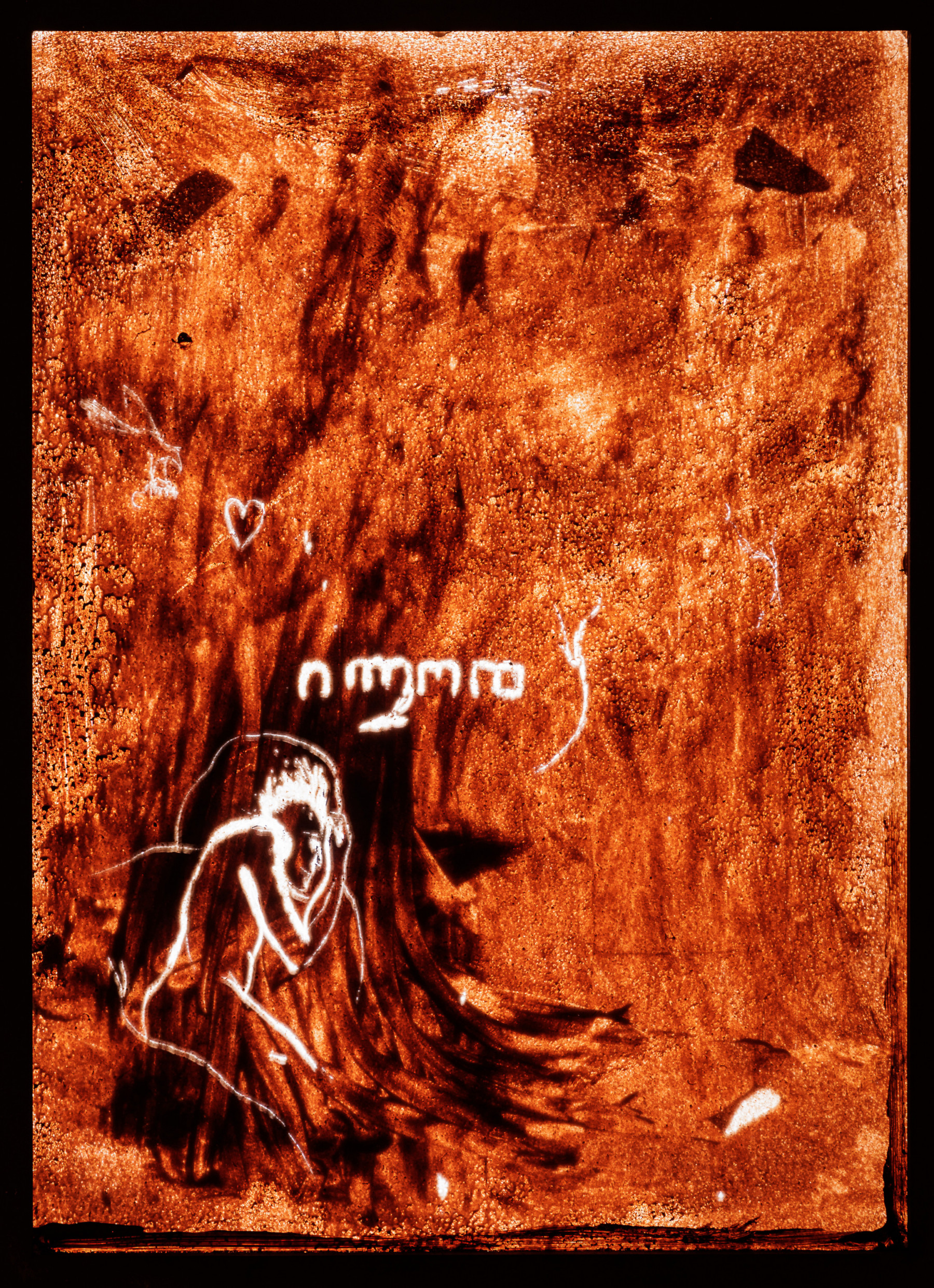
Tolia Astakhishvili, I am the secret meat (Detail), 2022, Acrylfarbe, Plexiglas, Sperrholz, LED-Beleuchtung, Courtesy die Künstlerin, LC Queisser, Tbilisi und Felix Gaudlitz, Wien
Light shimmers from behind the window through a mud-like layer. It intensifies the shapes of body parts that look as if painted with a finger on the dusty windscreen of a car; a confession of love or an insult – things that can often be found on snow-covered glass or smeared bonnets. Here instead, you see hints and silhouettes of faces, bones, hands, and arms detached from the torso.
The windows of the dark first room of Tolia Astakhishvili’s solo exhibition "The First Finger (chapter II)" at Berlin’s Haus am Waldsee are covered in sketches of bodies. The exit – a rectangle of thin veins glowing in the wall – is hard to find. Once you go through it, you’re dazzled by the light from the gallery’s generous garden windows. In the rooms of this sprawling villa in Zehlendorf, Astakhishvili (*1974, Tbilisi, Georgia) consistently explores questions of space, architecture, and nostalgia. A former home, the villa is transformed into a metaphor not only for protection and comfort, but also for violence, loneliness, and decay.
"The First Finger (chapter II)" is the second iteration of the exhibition that was on view at Bonner Kunstverein earlier this year. In addition to structural interventions, drawings, paintings, text, and videos, it includes new collaborative works and contributions by twelve other artists and writers [1], some of them Berlin-based.
The installation The First Finger (wintergarden) (2023) on the ground floor was developed in collaboration with Andreas Rousounelis, Giorgi Zhorzholiani and Dylan Peirce. On the floor of the wintergarden, pieces of a cut tube are spread out, an architectural model is semi-covered with parts of a fencing suit and a handle, still smeared with rust from times when it was a tool and belonged to someone. There are also different hand soaps, shaped from endless handwashing into cracked objects. They are the colour of bones, exposed to the sun for too long.
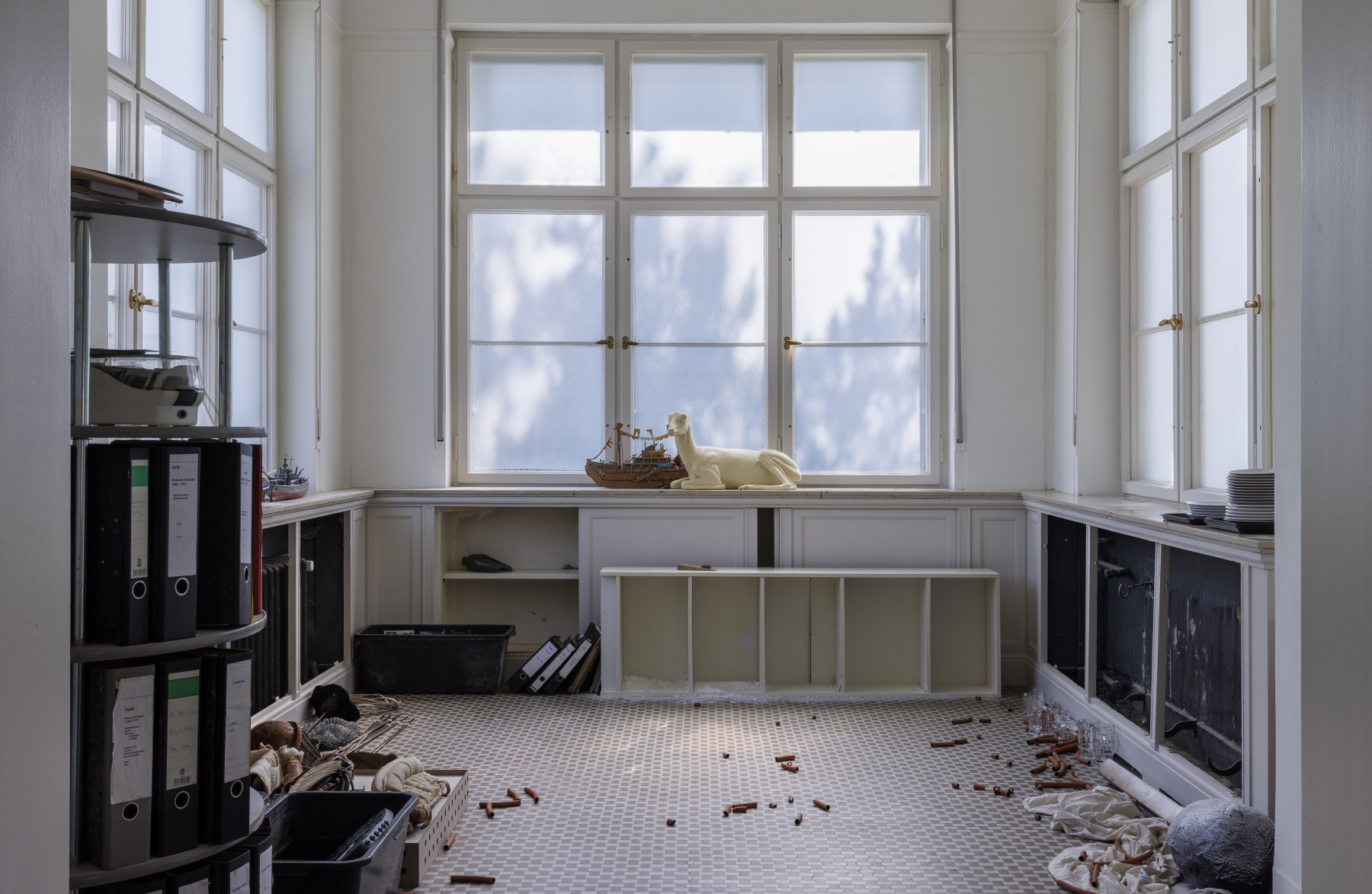
Tolia Astakhishvili, The First Finger (wintergarden), 2023, Installationsansicht Haus am Waldsee, 2023, Courtesy die Künstlerin und LC Queisser, Tbilisi, Foto: Frank Sperling
In the midst of this spacious installation, an eerie feeling crawls from the dusty corners, that makes you want to know what has happened here – and also not. Astakhishvili works directly with the space and architecture she finds herself in. Before becoming a gallery, Haus am Waldsee was a residence built in the style of an English country house. The artist takes this into her expansive installations: There is something domestic about her work that recalls an attic full of objects from different generations, sealed for a long time and opened again, blinking into the sunlight.
Astakhishvili’s interaction with her environment is impressive: she deinstalled the radiators and removed their wooden panels, leaving the dusty imprint of their existence and flaking wall paint. She peeled away the different layers of the building, literally, revealing the different structural levels of the house.
The gap where the heaters once were is surrounded by more objects. Glasses on the floor, things of mysterious provenance and dusty wrinkled fabric, the famous IKEA Billy shelf with snow-like dirt in its corners. All these objects are familiar and charged with memories, good and bad ones. They also become mute players in The First Finger (wintergarden) for a scene that leaves us perplexed. There is no broader context for how this arrangement happened, where the files stacked in one corner came from or to whom the two model-boats placed on the dry windowsills belong.
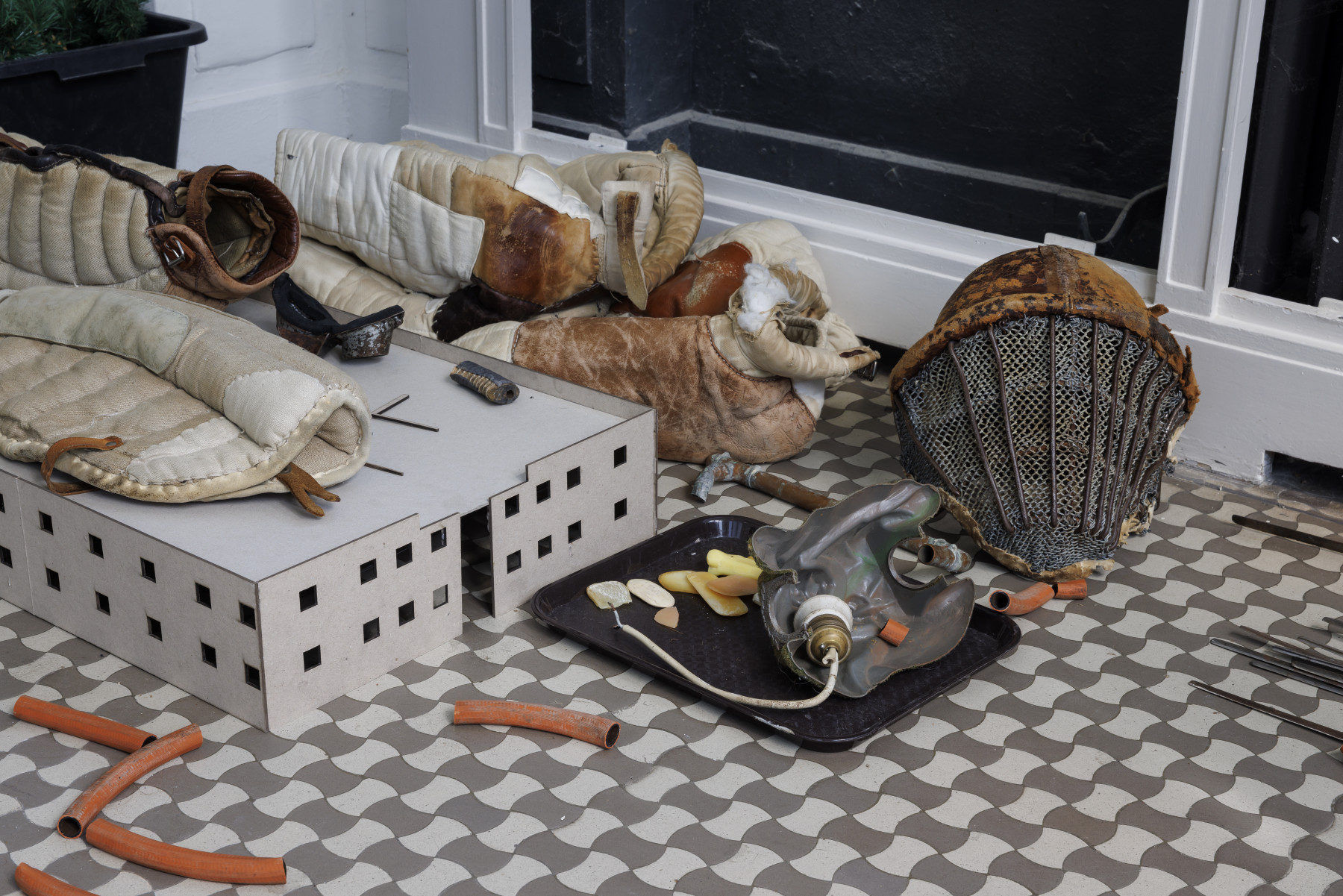
Tolia Astakhishvili, The First Finger (wintergarden),(Detail), 2023, Installationsansicht Haus am Waldsee, 2023, Courtesy die Künstlerin und LC Queisser, Tbilisi, Foto: Frank Sperling
Miniatures and models are a recurrent motif throughout the exhibition. The architecture model in the wintergarden was constructed in collaboration with her father, Zurab Astakhishvili. It is part of a joint series of models of various architecture in Tbilisi, where the artist grew up. Another one appears on the first floor of the exhibition. Untitled (2023) depicts a building that – even after decades of construction – was never completed and remains unfinished. The model serves as an interface between reality and projection or – like in Untitled – as the surface for an idea doomed to failure, whose translation into reality did not happen.
Continuing upstairs, the original floor plan of Haus am Waldsee is no longer recognizable. Sheetrock and corrugated metal partitions have been installed, corners have been smeared with plaster-like material and windows completely disappeared. A new environment emerges, marked only by traces – thin pencil lines and screws in a wall – as if to attach a shelf, which never happened. Drawings with sketchy shapes on chequered paper repeatedly appear in the exhibition. They are presented in recesses within the artificial walls on the first floor. A depth is created, like several passe-partouts laid on top of each other, embedding the actual drawing deep into the wall.
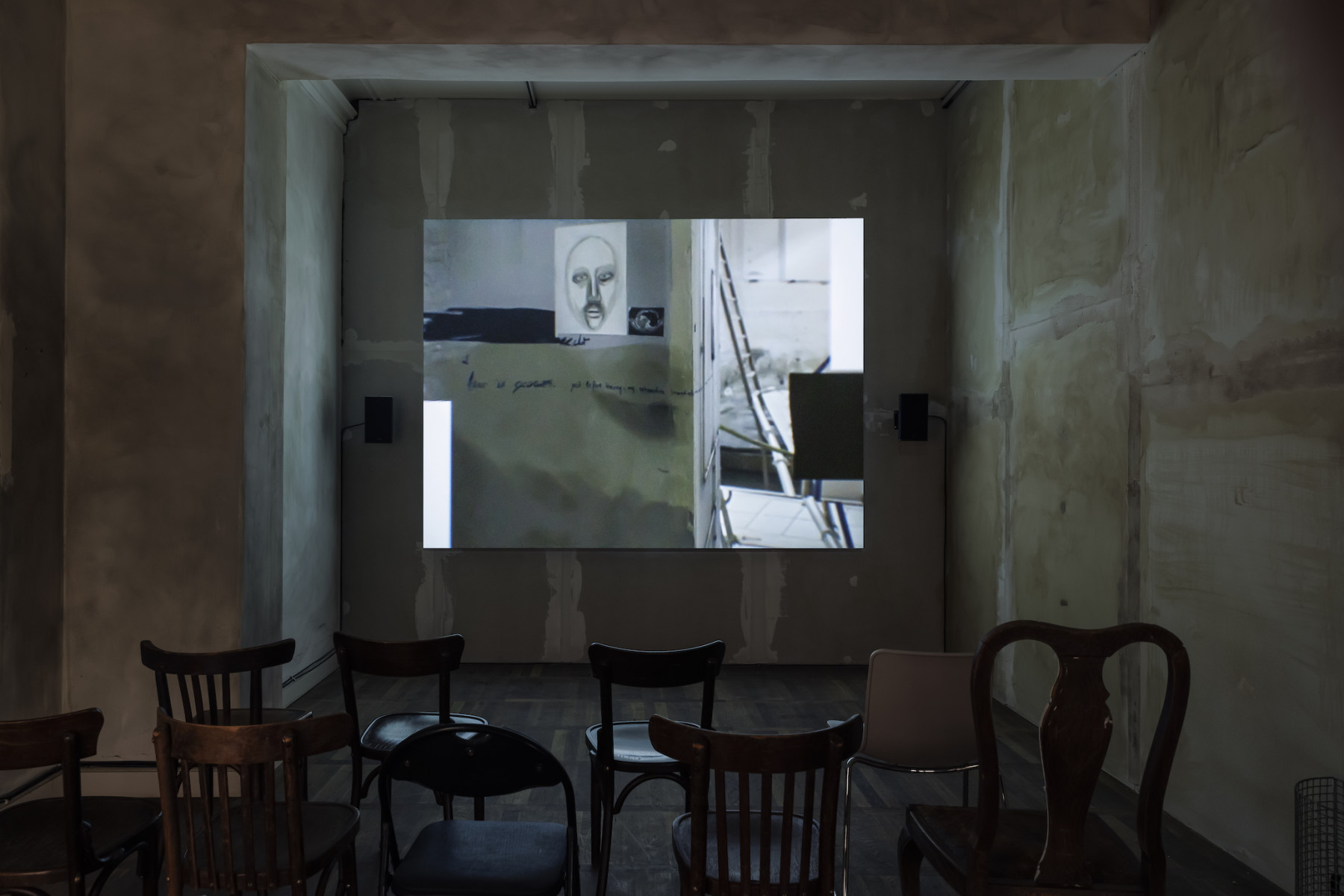
Tolia Astakhishvili & James Richards, I Remember (Depth of Flattened Cruelty), 2023. Videoinstallation, 10 min, Installationsansicht Haus am Waldsee, 2023, Courtesy die Künstler*innen; Cabinet, London; Isabella Bortolozzi, Berlin; Rodeo, London/Piraeus
A sense of spatial confinement is also conveyed in the work I Remember (Depth of Flattened Cruelty) (2023) made in collaboration with British artist James Richards. In the video, footage of empty underground rooms is digitally collaged with older works by Astakhishvili. The camera travels through narrow corridors and over open concrete walls from which metal stems protrude. Again, people are not present, but their traces are – scribbles on the wall, an old-fashioned television in the corner and distorted shots of newspaper clippings and animal photographs. It is no longer possible to tell what is real or what is imaginary.
This aspect of imagination can also be found back on the first floor. A construction of metal walls extends into the exhibition space. There is a humming behind them, overlapping the crashing sound of rubble being unloaded with the screech of a jackhammer. The sound installation I have no constraints, the only limit is me (2023) is one of several collaborations with multidisciplinary artist Dylan Peirce. It is strange to listen to this mysterious construction site behind the structure; the sounds pouring through the exhibition spaces feel queasy. Without explanation, visitors move along this kind of uncanny border between experiences and space, which Astakhishvili skilfully creates within her work. The feeling is akin to seeing the ghost of a family portrait that once hung on a wall.
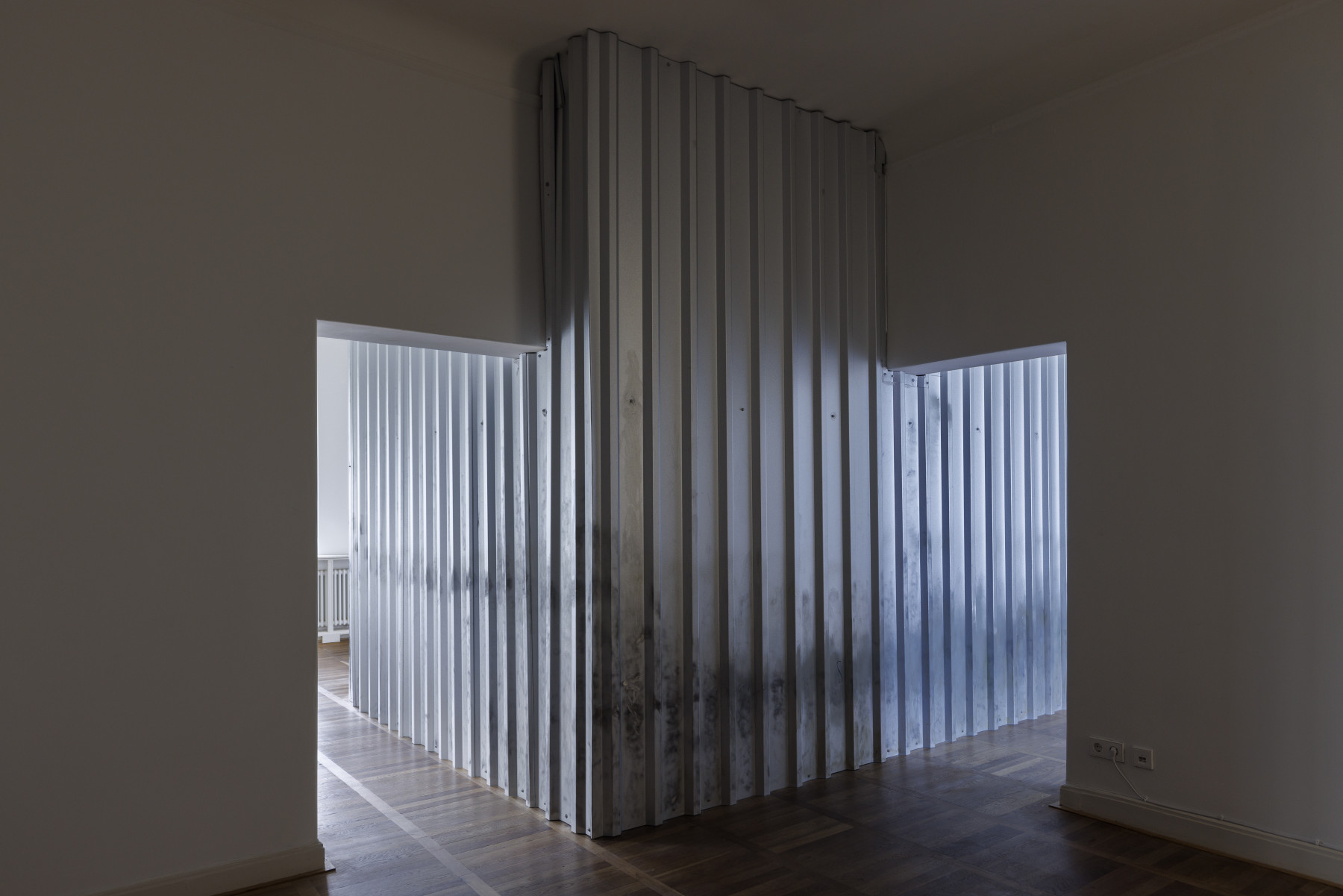
Tolia Astakhishvili & Dylan Peirce, I have no constraints, only limit is me, 2023, Installationsansicht Haus am Waldsee 2023, Trapezblech, 8-Kanal-Audioinstallation, 50 min, Loop. Courtesy die Künstler*innen; LC Queisser, Tbilisi, Foto: Frank Sperling
In her brilliant essay included in the exhibition booklet, the writer and art historian Kirsty Bell calls this undertaking 'multi-channelled'; an approach that defies singularity or categorisation. Astakhishvili’s installations have this quality precisely because they challenge immediate assumptions about their meaning. I was reminded of the chapter “The Benefits of Not Knowing” from “The Other Side: A Journey into Women, Art and the Spirit World” (2023) by Jennifer Higgie. In her book, Higgie expresses her admiration for artworks that resist her own “often hasty attempts to understand, justify or ascribe value.” [2] This also happens in The First Finger (chapter II). Here, not knowing animates the various collages of objects and opens up space for imagination. While looking at these sometimes strange and aesthetic arrangements, you occasionally feel a certain unease – not least because clear assumptions about the meaning of the abandoned settings are impossible.
Like so much in this show, nothing is one dimensional. The artist’s clever approach to space suggests that home does not only mean a pleasant environment. It also means looking into the moist corners of a house, scraping away mould and removing spider webs to see what is beneath and behind. What you will find, however, is nothing that explains itself. It is just one layer of many stories a house can hold.
[1] New collaborative works with Zurab Astakhishvili, Dylan Peirce, and James Richards, as well as contributions by Antonin Artaud, Alvin Baltrop, Kirsty Bell, Nat Marcus, Vera Palme, Andreas Rousounelis, Judith Scott, Ser Serpas, and Giorgi Zhorzholiani.
[2] Jennifer Higgie, The Other Side: A Journey into Women, Art and the Spirit World, 2023, Weidenfeld & Nicolson, p.79.
The First Finger (chapter II)
Tolia Astakhishvili
23/06 – 24/09/2023
Curated by Beatrice Hilke
Haus am Waldsee
Argentinische Allee 30
14163 Berlin